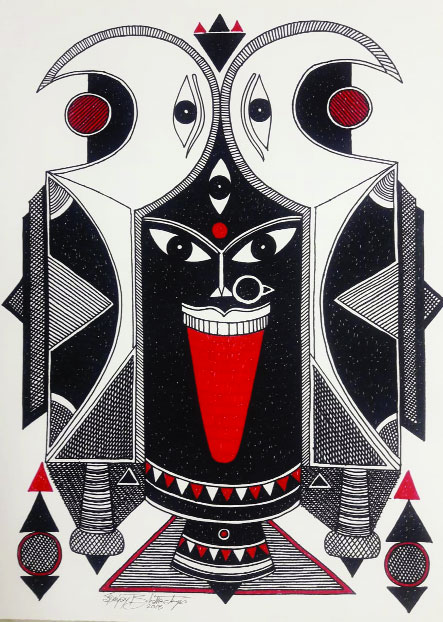Curator Kounteya Sinha celebrates Kali by showcasing four drawings of the black goddess by artist Sanjay Bhattacharya in her various moods. By Uma Nair
Standing with one foot on Shiva’s chest and her enormous red tongue stuck out, artist Sanjay Bhattacharya uses the form of Kali, the Goddess, in graphic interpretations to create four drawings that celebrate the common image of Kali in her mêlée mood.
Curator Kounteya Sinha celebrates the black goddess in a show entitled Niguro at the Kolkata Design Fair.
“Kali’s fierce form is strewed with symbols. Her black complexion symbolises her all-embracing and transcendental nature,” says Kounteya.
‘Just as all colours disappear in black, all names and forms disappear in her,’ said Mahanirvana Tantra by Sir John Woodroffe. Her nudity is primeval, fundamental, and transparent like nature that constitutes the Earth, the sea and the sky. Kali is free from the illusory covering, for she is beyond all maya or “false consciousness.” Kali’s garland of fifty human heads, that stands for the fifty alphabets of the Sanskrit language, symbolises infinite knowledge.
Kali’s form
“For me, Kali is not a religious symbol, she is a form,” says Bhattacharya. He creates a stunning symbolism through shades of vermillion, black and grey. The geometry and abstraction creates contours which form a confluence of an aura that is unmistakable.
Historians state that Kali in her manifestation has many messages. Her girdle of severed human hands signifies work and liberation from the cycle of karma. Her white teeth show her inner purity and her red lolling tongue indicates her omnivorous nature — “an indiscriminate enjoyment of all the world’s flavours.” Her sword is the destroyer of false consciousness and the eight bonds that bind us. Bhattacharya gives us Kali in her monumental magnificence through his four drawings.
“Her three eyes represent the three modes of time — past, present, and future — an attribute that lies in the very name Kali (Kala in Sanskrit means time),” says Bhattacharya. The images create many reflections that we can recall from literature as well as ancient texts. The eminent translator of Tantrik texts, Woodroffe in Garland of Letters, writes, “Kali is so called because She devours Kala (time) and then resumes Her own dark formlessness.”
Mahabharata
Historian Devdutt Pattnaik says that in the Mahabharata and Ramayana, composed around the third century BC, time and goddesses including Kali were given more character. They were usually independent and wild, appearing as manifestations of divine rage and embodiments of the forces of destruction.
In the Mahabharata, for instance, the nocturnal bloodbath by Ashwathama at the end of the 18-days long war slaughtered Pandavas’ innocent children rather dastardly while they are asleep. This is seen as the work of “Kali of bloody mouth and eyes, smeared with blood and adorned with garlands, her garment reddened — holding noose in hand — binding men and horses and elephants with her terrible snares of death.”
Defender against demons
Devdutt also states that in the Devi Mahatmya, dated roughly to eighth century AD, Kali became a defender against demonic and malevolent forces and by the 19th century, Kali was a goddess of mainstream pantheon, a symbol of divine rage, of raw power and the wild potency of nature. The one who was once feared as an outsider had made her way right to the heart of the mainstream.
Devdutt narrates a story: “They say that Shiva never spoke a single word until Shakti came in his life as Parvati. She became not only his wife, but also his student, asking questions, discussing and deliberating with him, till he revealed to the world the mysteries of life. One day, she asked him, ‘What is love?’”
“When you dance atop me as Kali, naked with hair unbound, unafraid to be yourself, to be powerful and vulnerable and of being judged and mocked, I feel love. You make me open my eyes. I realise that Lalita, the beautiful one, is also Bhairavi, the fearsome one. I realise Mangala, the auspicious one, is also Chandika, the violent one. I see you totally, without judgement and realise I am capable of seeing the truth. That you allow me to see you fully, without judegment, tells me that I have become trustworthy. Thus you become the mirror, the Parvati darpan, that reflects who I am. You help me discover myself. You become my Saraswati. You reveal the true meaning of darshan. In joy, I dance, I become Nataraj.”
In Kolkata, set in an old mansion, Bhattacharya’s Kali drawings will bring together the incantation of an incandescent spirit that surges and speaks to those who are willing to believe amongst the crowds. Perhaps in more ways than one, the words of an old hymn will swing into the air. “O Mother, even a dullard becomes a poet who meditates upon thee raimented with space, three-eyed, creatrix of the three worlds, whose waist is beautiful with a girdle made of numbers of dead men’s arms…” (from a Karpuradistotra hymn, translated from Sanskrit by Sir John Woodroffe.)


























